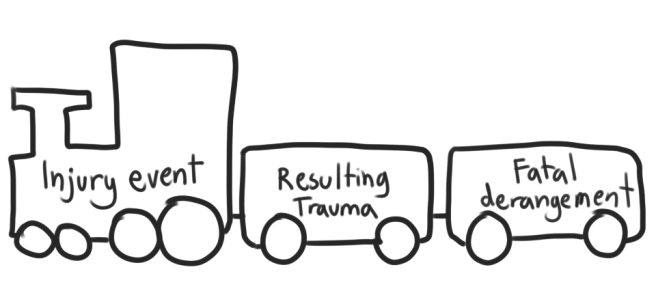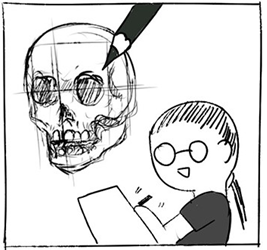MECHANICAL INJURY
Mechanical injury is caused by mechanical energy.
Energy is classified to 5 categories; radiation, electrical, physical, chemical and mechanical. Mechanical energy is the sum of kinetic energy (the energy an object contains because of its motion) and potential energy (the energy an object contains in its state of rest). Both types of energy can be transferred from an object to another. If the energy is transferred to a human body, it caused mechanical injury.
Example 1

A man (got potential energy)….
….lifts his foot up
(got more potential energy on his foot than its previous position)….
….then stomps down (got kinetic energy which sums up with potential energy to be mechanical energy) onto another man’s belly (got transferred mechanical energy from the first man’s foot). The mechanical he received causes a rupture to his liver (mechanical injury).
Example 2

A rock on a cliff (got potential energy)…..
…..rolls down towards the ground (got kinetic energy along with potential energy which sums up to mechanical energy)…..
…..then hits a man’s head (got transferred mechanical energy from the rock). The mechanical energy causes his head injury (mechanical injury).
Example 3

A bullet in a gun
(got potential energy from its mass)….
….is fired and travels
(got kinetic energy from being pushed by gunpowder explosion along with potential energy which sums up to mechanical energy)….

….then hit a man’s chest
(got transferred mechanical energy from the bullet),
causes penetration of his heart (mechanical injury).
Mechanical injury could be classified into 3 categories based on types of weapons.
Mechanical injury could be classified as:
- Blunt force injury, caused by blunt weapon which may be an object; such as rock, hammer, steel bar and wooden stick; or a body part; such as foot, fist and elbow.
- Sharp force injury, caused by sharp weapons; such as knife, ax, ice pick and machete.
- Gunshot injury, caused by firearms; such as pistol, revolver, rifle and shotgun.
CAUSE OF DEATH
Four terms related to ‘Cause of death’.
The first one is “cause of death” itself, which will be called COD as an abbreviation later on. “Cause of death” is defined by WHO, coded only injury related description, as “all those ….. injuries which either resulted in ….. death and the circumstances of the accident or violence which produced any such injuries.”
According to the definition, COD is not just something that happens within a human body which leads his/her death. It is not a point of time which a vital organ stop working either. It is a process that is similar to a train. One leads to another one, which leads to another one, and so on. The COD-TRAIN is mainly composed of 3 compartments: injury event, resulting trauma and fatal derangement. The later ones follow the former ones. [1]

Injury event is the external condition which is the main cause leading to body damage. It is the actual cause that initiates the chain of process which leads to death. It is called underlying or proximate cause of death which is the second term related to COD. [1-4] For example, a man was stabbed which made him die an hour later. The event which led him to death was stabbing. So the underlying COD is ‘stabbing’.
The trauma resulting from the injury event is called intermediate COD. It is the damage of bodily tissue directly resulted from the external cause or event. [2-4] Refer to the case in previous example, the knife was put through his chest and penetrated into his heart. Penetration of the heart was the resulting trauma or intermediate COD.
The last term related to cause of death is immediate COD. Immediate COD is sometimes called fatal derangement. It is the final consequence of underlying COD, producing anatomical or functional impairment that causes the person die. [1-4] The person who was stabbed to chest in the example got penetration of the heart which led to hemopericardium which caused him die. Hemopericardium was stated as the immediate COD.
Event = stabbing
underlying COD=stabbing
 Resulting trauma = penetration of heart
Resulting trauma = penetration of heart
Intermediate COD = penetration of heart
Fatal derangement = hemopericardium
Immediate COD = hemopericardium
How to determine the underlying cause of death
There are 2 categories of underlying cause of death related to mechanical injury.
1. Penetration and Sharp force injury
The determination of underlying COD in this group is based on wound type responsible for the death.
Wound type Underlying COD
gunshot wound gunshot injury
cut wound (on throat) cut throat
chopping wound chopping injury
stab wound stabbing injury
2. Blunt force injury
Information of wounds and circumstances of death is needed to determine the underlying COD in this category.
Wound type, the number and location of wound along with injurious object is very helpful for COD determination. Some wound is specific to the cause such as sole mark which relate to death by stomping. The degree of wound distribution over the body is also the clue lead to underlying COD. Many wounds scattered all over the body which mainly on prominent parts suggests traffic injury more than beaten to death.
Fracture of large and/or deep bones; such as pelvis, femur, thoracic and lumbar spine; scarcely found in beaten to death.
A circumstance of death is very meaningful to underlying COD. Sometimes findings from body examination are not much helpful. In this case, it is needed to have information from witness who saw the event and information from family or friends. For instance, a man had been sick from pancreatic cancer. He had chronic serious abdominal pain for months and was admitted to a hospital. Many witnesses saw him climbed and jumped out of the window on the 9th floor of the hospital building to the road. The circumstance is obviously revealed the underlying COD.
The place where the body found is found is another clue for the determination of underlying COD. For example, a body with serious blunt force injury on the head and face found next to a trail in a forest supposedly died from being hit by someone rather by traffic injury.
‘Mechanism of death’ comes after cause of death.
Mechanism of death is the altered physiology resulting from COD. It is terminal process which is just the fact of death and not specific to particular injury which means more than one COD could lead to the same mechanism. The example of mechanism of death includes exsanguination or hemorrhage, hypovolemic shock, cardiac tamponade, cardiac arrhythmia, secondary wound infection, sepsis, respiratory depression, etc. [3,5]
There are 2 components of mechanism of death. Terminal event is the common final pathway of death. It is composed of 6 items which are asystole, cardiac arrest, ventricular fibrillation, cardiopulmonary arrest, electromechanical dissociation and respiratory arrest. The other component is non-specific physical derangements which are between immediate COD and terminal event. [3]
MANNER OF DEATH
Manner of death is the circumstance of death.
Manner of death (MOD) is the circumstance that put a person in the COD-train. MOD in case of non-natural COD could be classified into homicide, suicide, accident and undetermined.
Homicide is the circumstance in which the victim’s death was caused by another human by intention or by criminal negligence. Suicide is the act which the death is caused by one’s own intentionally. This MOD will be considered when there is evidence that he/she wished to die and understood the result of his/her action. If the death is caused by unintentional act, it will be classified as an accident. Sometimes the evidence to determine MOD is not enough. In this situation, the MOD should be stated as undetermined. [2-6]
Determination of MOD needs evidences.
MOD is determined by the result of the autopsy and the circumstances of death. It should be decided after having thorough facts of death from the doctor who examined the body, police, investigators, family and friends. [2,4,6]
Some MOD relates to the type of COD. Dying by beaten or chopping is related to homicide. Traffic injury is mostly caused by accident. Distant shot by firearms mostly occurred from homicide.
Wound on some parts of the body indicates the MOD. Cut wounds on the deceased’s palm showed that he/she defensed him/herself from being attacked, which means homicide was the MOD. But if multiple shallow cut wounds was found on volar aspect of the wrist, especially opposite side of dominate hand, suicide is supposed to be the MOD.
Finding which does not get along with the overall circumstance, such as ligature mark around the neck of the victim who died from falling, points to homicide.
Toxicological analysis is valuable in MOD determination. The victim with high level of substance more than he/she could do the act which led him/her die, homicide would rather be presumed as the MOD than suicide or accident.
Articles found at scene of death are also helpful; farewell note, messy scene as if someone had a fight, blood trail as if the body was dragged along the floor, absence of the weapon; for example.
Same as COD determination; witness, family and friends; usually give essential information leading to decision of the MOD.
Suicide is very difficult to decide as MOD. It is hard for family to accept that the deceased took his/her own life. Moreover, homicide can be made to be looked like suicide. Before making decision to determine suicide as the MOD, the person should find evidence that reveals the intent to kill him/her-self such as farewell letter, expression of hopelessness, both verbal and nonverbal, previous suicidal attempt, stressful event, preparation for death, precautions to avoid rescue and mental disorder. [2]
What if the person died a long time after the event?
Some deceased survived from the event and died later on, long time after then, from some disorders. For example, a man had head injury from being assaulted. After spending 2 years in bed ridden status, he died from post-traumatic seizure.
The question is what should be put as the MOD? Natural, from seizure? Or homicide, according to the assault?
It is stated in a guideline made by Center of Disease Control (CDC) that if death was brought about by an injury, preference is given to the injury when classifying the MOD because death would not have occurred if the injury had not occurred, regardless of the interval between the injury and death. [3] If based on the guideline, MOD of the case in the previous example would be classified as homicide.
Determination of MOD could be different among doctors who perform autopsy.
Because MOD is based on evidence and opinion, disagreement could occur among the ones who give the determination. National Association of Medical Examiners used to do a survey on MOD determinations from the members.
A set of scenarios with full information of CODs and circumstances was presented to those medical examiners and required them to determine MOD in each case. Not even one scenario that every of them have 100% agreement. In a case, their opinions were 50:50 for homicide:accident. [3] No one could judge another one’s determination as incorrect. It is opinion over the evidence. And it can be changed after more evidence is discovered.
CAUSE-OF-DEATH STATEMENT
There are 2 objectives of COD statement.
COD-statement is the chain of event starting from immediate COD to underlying COD or vice versa. It serves 2 basic purposes, legal and public health, which includes vital statistics, research and public health planning. To achieve the purposes, COD statement must be accurate and complete as much as the circumstances allow. [1-3] The question is what is so-called ‘complete COD statement’?
A complete COD statement reports the entire sequence of the events leading to death.
COD statement should be written in complete sequence including injury event (underlying COD), resulting trauma (intermediate COD) and fatal derangement (immediate COD). There are 2 ways to write it down. The first one is writing from immediate COD to underlying COD using ‘due to’ as conjunction. For example, hemopericardium due to perforation of heart due to stabbing to chest. The other type is to write underlying COD first then go through all process to immediate COD using ‘leading to’ to link them off. Stabbing to chest, leading to perforation of heart, leading to hemopericardium, as an example. Never use abbreviation or symbol in the certification. [2,7]
In writing COD statement, there is no need to state every single compartment in COD-train if the term used in a compartment can cover all. For example, ‘perforation brain trauma due to gunshot wound of head’ is enough. The underlying statement, ‘due to firearms injury’, can be omitted. If underlying COD is not known, it is fine to put only immediate and intermediate COD in the COD statement, such as ‘subdural hemorrhage due to blunt head injury’. [2,3,7]
In case of more than one condition led the person to death and the certifier cannot determine which one was most likely to be the COD, a guideline [7] suggests to put them all. For example, hemothorax and subdural hematoma due to falling. Another guideline [3], on the other hand, states that the certifier should be able to choose the priority to make the person die as the COD, not to put all.
Anyhow, the most important matter is to report underlying COD. Public health organization pursues intervention to break the sequence leading to death. Underlying COD is what they focus on because it leads to process intervention as early as possible. [2]
Mechanism of death in COD statement is sometimes beneficial.
Some said mechanism of death should be never ever reported in COD statement. The problem is sometimes it is not easy to determine which one is and which one is not mechanism of death. It is variable defined from one guideline to another. And sometimes the so-called mechanism of death is useful for public health planning or treatment. There are many times certifier asked him/herself whether this or that should be included in COD statement in the COD statement or not.
To answer the question, the certifier should ask him/herself whether it is helpful to make it achieve the basic purposes, legal and public health. For autopsy report, its benefit is barely. But for public health research and planning, surely some are valuable and should be reported in death certificate. So mechanism of death should be included in COD statement on death certificate if it is useful for national mortality database improvement. On the other hand, exclude it if it provides no additional information on the COD. [1-3,7]
Thinking of the usefulness of mechanism of death, terminal event which composed of 6 items mentioned earlier, is merely common final pathway of death or mode of dying which is not useful neither for legal issue or public health planning. For this reason, none of them should be written down as a part of COD statement. [1,3,7]
Considerations for certifier
Certifier is free to write whatever he/she believes it is the best and most useful COD statement. Some considerations can help in writing it properly. [2,3,7]
- COD statement must be accurate and complete as much as circumstances allow and reach the highest usefulness of the information both in the term of legal and public health purposes.
- Certifier is expected to write COD statement to the best of his/her knowledge. Even though, he/she should not be expected to be flawless.
- Clarification of the COD statement on death certification is crucial. However, the certifier must concern that total disclosure of the whole circumstances could interfere with criminal investigation.
- Every certifier should be provided enough flexibility to meet the need of each case.
- Death certification writing methods should be enslaved to classification and coding rule.
Some examples of COD statements for mechanical death
- Hemopericardium due to perforation of heart due to stab injury
- Cerebral contusion due to fracture skull due to blunt force trauma of head due to traffic injury
- Penetration of brain due to gunshot wound to head
- Intrathoracic hemorrhage due to stab wound of lung
- Spinal cord transection due to cervical spine dislocation due to fall from height
- Hemorrhage due to hemoperitoneum due to liver laceration due to stomping
References
- Department of Health. Implementation of the tenth revision of the international statistical classification of diseases and related health problems: Guidelines for completion of medical certificate of the cause of death. URL:http://www.chp.gov.hk/files/pdf/medcert.pdf. Accessed on 22 December 2016.
- Center of disease control and prevention. Medical examiners’ and coroners’ handbook on death registration and fetal death reporting. URL:https://www.cdc.gov/nchs/data/misc/hb_me.pdf. Accessed on 22 December 2016.
- Hanzlick R.L. editor. The autopsy committee and the forensic pathology committee of the college of American pathologists, The national association of medical examiners. Cause-of –death statements and certification of natural and unnatural deaths. URL:https://netforum.avectra.com/public/temp/ClientImages/NAME/8c58e7e9-b2fa-44a9-8d1b-3085cd14bf25.pdf. Accessed on 22 December 2016.
- Shaw E. Certification of cause and manner of death. URL:https://poptop.hypermart.net/deathcert.html. Accessed on 22 December 2016.
- Uthman E. Forensic pathology. URL:http://web2.airmail.net/uthman/forensic_path.html. Accessed on 22 December 2016.
- Cox W.A. Cause, mechanism, and manner of death. URL:https://forensicmd.files.wordpress.com /2009/11/cause-and-mannerdoc.pdf. Accessed on 22 December 2016.
- Meadows N.S. Death certification: Guidance for doctors certifying cause of death. URL:http://www.manchester.gov.uk/download/downloads/id/6147/death_certification_-_guidance_for_doctors_certifying_cause_of_death.pdf . Accessed on 22 December 2016.

Written by:
Assoc Prof Karnda Mekjaidee, MD.
Department of Forensic Medicine,
Faculty of Medicine, Chiang Mai University

Illustration and Proofread by
Kanchanit Vichairat
BA (Hons) Graphic Communication,
Loughborough University, UK.
e-mail: chirosart@gmail.com
http://namvichai.wixsite.com/chiroart
